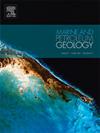Sedimentary control on permeability heterogeneity: The middle Buntsandstein continental sandstones (Lower Triassic, eastern France)
IF 3.7
2区 地球科学
Q1 GEOSCIENCES, MULTIDISCIPLINARY
引用次数: 0
Abstract
Understanding the influence of sedimentary processes on reservoir architectures can be essential for improving the prediction of permeability heterogeneity. The Upper Rhine Graben offers an ideal geological context for using outcrops as reservoir analogues, as the rocks cropping out at the Graben's shoulders belong to the same formations that host lithium-rich geothermal brine in the Graben. The interval of interest in this study, the upper section of the Lower Grès Vosgien Formation (LGV), consists of fluvio-aeolian deposits considered preferential zones for fluid migration within the Buntsandstein Group. In this study, the main factors controlling permeability heterogeneity distribution of these fluvio-aeolian deposits are presented, in different scales, by combining permeability and petrographic characteristics with quantitative sedimentological characterisation of the LGV. The fluvial channel facies association (FA), predominantly composed of cross-bedded sandstones deposited in braided channels, exhibits higher permeability compared to the wind- and water-laid FA, made up of sandstones deposited in a sand-sheet-dominated aeolian system. Vertical profiles reveal permeability contrasts of up to four orders of magnitude between these FAs. At the facies scale, the fluvial channel FA shows a distinction in permeability associated with facies formed under different flow-regime conditions. Trough cross-bedded sandstones, formed under lower flow-regime conditions, exhibit higher permeability than low-angle cross-bedded sandstones, formed mainly under upper flow-regime conditions. In the wind- and water-laid FA, permeability distribution is directly influenced by palaeoclimatic variations. Low-permeability hybrid sand sheets (HSS) were deposited under relatively humid conditions, while high-permeability aeolian dunes (AD) formed during more arid periods. Despite the high permeability of the AD, the architecture of the wind- and water-laid FA suggests that the AD have low connectivity potential. The lateral continuity of the wind- and water-laid FA, extending over hundreds of metres, combined with the dominant occurrence of low-permeability HSS, indicates that this facies association may act as flow baffles or barriers. Compaction is the main process influencing the permeability and porosity of the LGV. Samples with a higher proportion of lithoclasts and infiltrated clay recorded a more advanced degree of compaction. In contrast, samples with a higher percentage of quartz overgrowth were less compacted. The diagenetic overprint affected the distinct facies differently, indicating that primary sedimentary processes and architecture govern the distribution of permeability heterogeneity in the LGV. Permeability data from outcrops exhibited median values up to three orders of magnitude higher than those from subsurface data. However, the same facies and similar trends of relative porosity-permeability responses to the distinct sedimentary features are observed in both outcrops and borehole samples. This highlights sedimentology as an essential resource for reservoir heterogeneity studies.
求助全文
约1分钟内获得全文
求助全文
来源期刊

Marine and Petroleum Geology
地学-地球科学综合
CiteScore
8.80
自引率
14.30%
发文量
475
审稿时长
63 days
期刊介绍:
Marine and Petroleum Geology is the pre-eminent international forum for the exchange of multidisciplinary concepts, interpretations and techniques for all concerned with marine and petroleum geology in industry, government and academia. Rapid bimonthly publication allows early communications of papers or short communications to the geoscience community.
Marine and Petroleum Geology is essential reading for geologists, geophysicists and explorationists in industry, government and academia working in the following areas: marine geology; basin analysis and evaluation; organic geochemistry; reserve/resource estimation; seismic stratigraphy; thermal models of basic evolution; sedimentary geology; continental margins; geophysical interpretation; structural geology/tectonics; formation evaluation techniques; well logging.
 求助内容:
求助内容: 应助结果提醒方式:
应助结果提醒方式:


